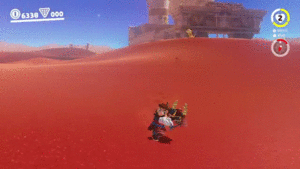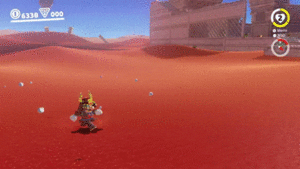Cap Jump
The Cap Jump[1] is a move that debuts in Super Mario Odyssey. The move involves Mario jumping from Cappy, which allows Mario to jump higher than normal. It does not reach as high as a Triple Jump or a Ground Pound Jump. However, it has one advantage both of those moves do not: the ability to be used while in the air. This means the Cap Jump can be combined with other jumping techniques, allowing Mario to get even higher or farther.
To perform the Cap Jump, the player must use the Cap Throw to get Cappy into position, then hold the or
button for the Cap Throw and Hold to keep Cappy in place. Finally, the player must either walk into Cappy or land on top of him. Mario automatically bounces up, and Cappy returns to him. The Cap Jump concludes a number of specific states, leaving Mario in a state largely equivalent to a normal jump no matter how he started.
While powerful, the Cap Jump has three restrictions. It cannot be used after a Wall Jump, it cannot be used more than once in the air, and releasing a captured entity prevents Mario from using the Cap Jump until he lands. In all cases, Mario will pass through Cappy. (Using a Cap Jump on the ground, then using a Cap Jump in the air is allowed.) Captured characters cannot use the Cap Throw, therefore implicitly preventing them from using the Cap Jump.
In two-player mode, the Cap Jump has two extra mechanics. If Cappy has taken off, walking into him does not trigger a Cap Jump. While Cappy is floating over Mario, the second player can press or
to cause Mario to cap-jump. The rules preventing multiple consecutive Cap Jumps still apply to this shortcut. Repeated presses only make Cappy jump from Mario. While Cappy can take off even while a character is captured, a captured character still cannot cap-jump.
The Cap Jump can also be used to perform an advanced technique known as the Cap Dive (referred to in-game as the Dive Jump). It consists of using a dive onto Cappy, canceling the diving state into the jumping state via the Cap Jump. This gives Mario the extra distance and speed from a dive, then boosts him up at the end with more control available than with the dive alone. This can allow Mario to travel across large distances in midair. To perform a Cap Dive, the player must jump, throw Cappy, and quickly dive into him while holding him in the air. If Mario lands on Cappy, he performs a Cap Jump. (It is possible to miss Cappy, most easily done by holding back to reduce the dive's distance.) Since it ended on a standard Cap Jump, Mario can use any technique following it except for another Cap Jump. The most obvious choice is diving again for more distance. This technique is required in order to reach certain secret coin piles, but it is otherwise completely optional for completing the game. Dive Jumps are the only move in the game with a Travel Tip but not an entry in the Action Guide.
The button sequence for the Cap Dive is as follows:
or
to jump (any kind of jump, except for Wall Jumps)
or
to throw Cappy
or
immediately after throwing Cappy to ground-pound
- Holding
or
to dive while keeping Cappy in the air
Profiles[edit]
- In-game sign: "Travel Tip: Dive Jump Jump and throw your cap, then while in the air press
and hold
. If you pull it off, you'll zoom straight to your cap and bounce really far!" (Different controllers display different buttons)
- In-game instruction text: "Jump and throw your cap, then while in the air press
and hold
to Dive Jump." (Different controllers display different buttons)
Names in other languages[edit]
| Language | Name | Meaning | Notes |
|---|---|---|---|
| Japanese | 帽子踏みジャンプ[?] Bōshi Fumi Janpu |
Cap Step Jump | |
| Chinese (simplified) | 踩帽跳[?] Cǎi mào tiào |
Cap Step Jump | |
| Chinese (traditional) | 踩帽跳躍[?] Cǎi mào tiàoyuè |
Cap Step Jump | |
| Italian | Salto col cappello[?] | Cap jump | |
| Korean | 모자 점프[?] Moja Jeompeu |
Cap Jump | |
| Russian | Прыжок со шляпы[?] Pryzhok so shlyapy |
Cap Jump |
References[edit]
- ^ SwitchForce (October 26, 2017). Super Mario Odyssey Exploring the Action Guide - All Moves Shown (NO SPOILERS). YouTube. Retrieved January 12, 2021.

